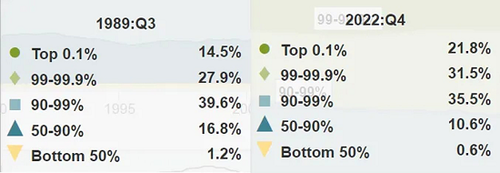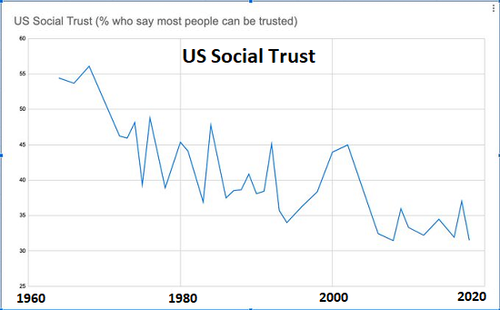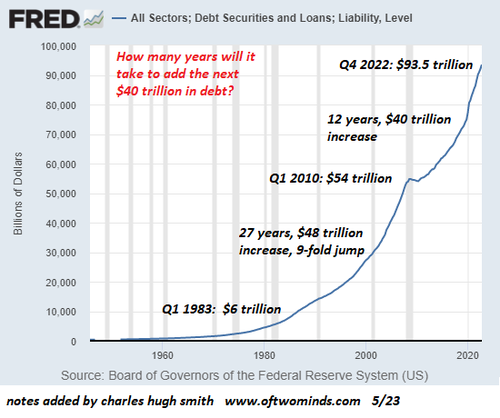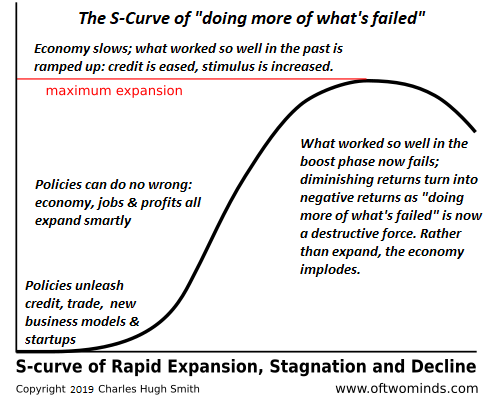Authored by Charles Hugh Smith via Of Two Minds,
Consider this description of America's discontent:
"...a Hamlet-like loss of self-confidence, with an apocalyptic sense of doom for the civilization. On the Right it embodies a conviction that the sensate culture is pushing the society down the Gaderene slope of drugs-and-fornication to destruction. On the Left there is the vague sense that America is imperialist, fascist-oriented, caught in inner contradictions of class and ethnic struggles which will end in self-destructive wars or civil chaos.
...the fragmenting and polarizing of institutions (family, neighborhood, university, church, nation)--in short, the overloading of the social nervous system by sudden accelerations of change."
Is that a reasonably fair description of America in 2023? Interestingly, it was written in January 1974, describing the America of 50 years ago. (America Agonistes (Max Lerner, Foreign Affairs, January 1974). I have often referred to Peter Turchin's evidence-based cyclical mapping of the structural sources of social disorder which he has updated in his latest work, End Times: Elites, Counter-Elites, and the Path of Political Disintegration.
Turchin identified 50-year cycles of integration--in which people find reasons to cooperate--and disintegration, in which people find reasons to devolve cooperation. From this perspective, that an article from 50 years ago sounds current is not only no surprise, it was easily predictable.
This Salon article summarizes many of the conclusions in Turchin's new book: Hope in "End Times": Peter Turchin's analysis of our coming collapse could help us avoid it:
For all its breadth and depth, there's a simple message at the core of "End Times": At the heart of our problems, Turchin writes, is "a perverse 'wealth pump' ... taking from the poor and giving to the rich," and we have to find a way to turn it off.
This reflects "one of the most fundamental principles in sociology, the 'iron law of oligarchy,'" he writes, "which states that when an interest group acquires a lot of power, it inevitably starts using that power in self-interested ways." For example, while wages fell far behind the growth of economic productivity from 1979 onward, Turchin cites analysis from the Economic Policy Institute indicating that three-fourths of that gap was due to elite-driven policy shifts: weakened labor standards, the erosion of collective bargaining, corporate globalization and so-called fiscal austerity.
Diminished economic conditions for the less educated were accompanied by a decline in the social institutions that nurtured their social life and cooperation. These institutions include the family, the church, the labor union, the public schools and their parent-teacher associations, and various voluntary neighborhood associations."
Back in America's previous cyclical crisis, Lerner identified the sources of decline in this way: "Civilizations die not only of rigidity, failure to meet challenges, constitutional breakdown. They may also die of deep alienations and the erosion of crucial institutions."
He concluded that America's cult of change precluded a decline due to rigidity:
"My own stress is on studying the crucial factors in the death of past civilizations, and using them to put questions concerning American directions. To start with, the rigidity which marked a number of declines and falls is only minimally present in America, with her cult of change and her experience of social and cultural revolution."
I will consider the issue of rigidity in upcoming posts, but for now, let's consider the decay of America's social and economic foundations, starting with Turchin's perverse wealth pump that has stripmined the bottom 90% to enrich the top 1%, as shown in this chart:
Social trust, a baseline measure of social stability, has eroded. It's worth noting that the tumultuous 1970s don't come off so badly in this chart compared to the present. It is not coincidental that social trust rose in the 1990s, when prosperity included the entirety of households and not just the top 10% and has since declined sharply as prosperity was concentrated in the top 10%.
The hyper-financialization and hyper-globalization of the economy--the engines of wealth and income inequality-- took off in 2000, more than tripling total debt. Soaring debt service is a consequential measure of financial decay:
Across every institution, the entrenched elites and incumbents now respond to decline by doing more of what's failed, a sign not of flexibility but of self-serving rigidity:
I'll consider an even more destructive manifestation of rigidity in my next post.



